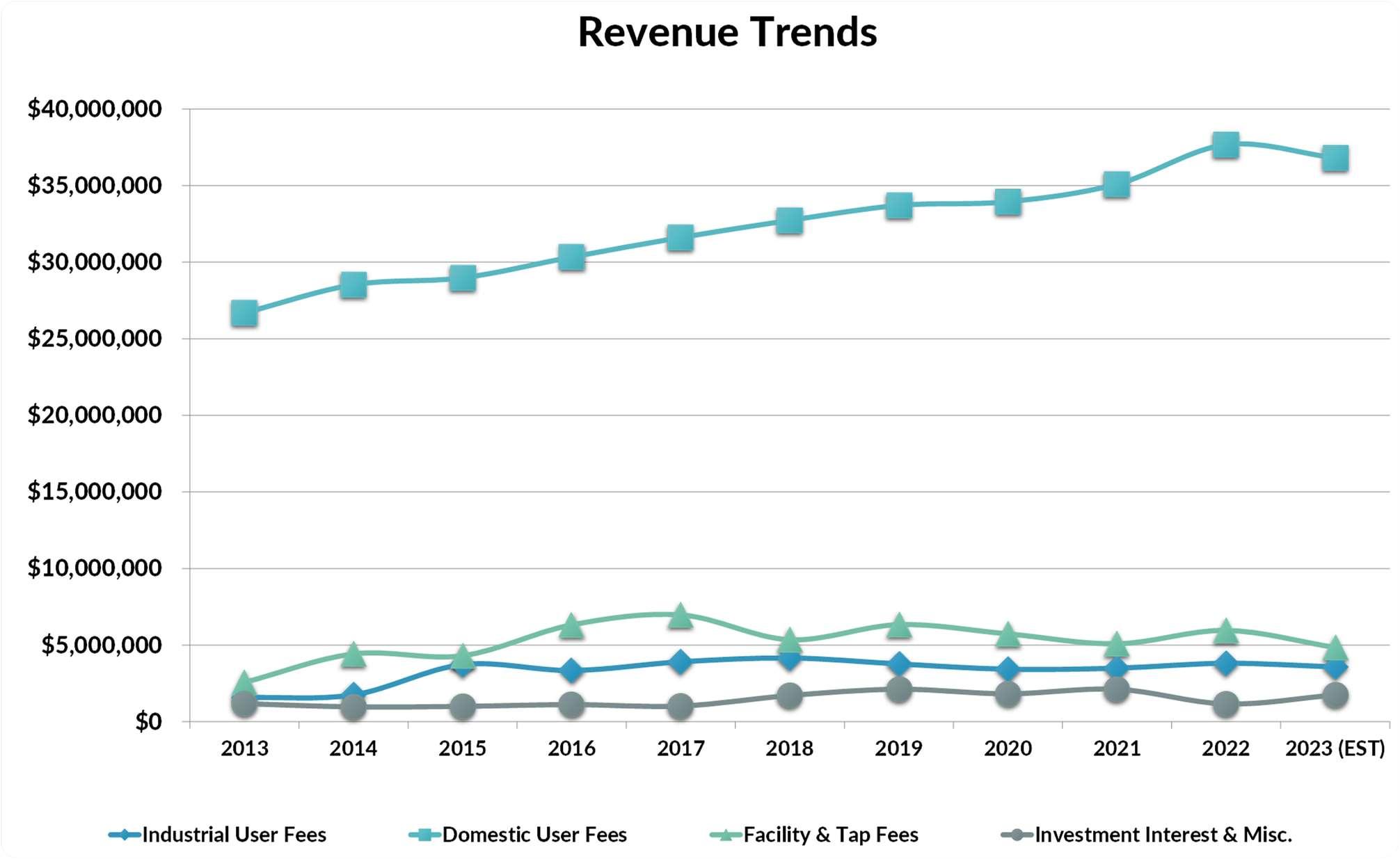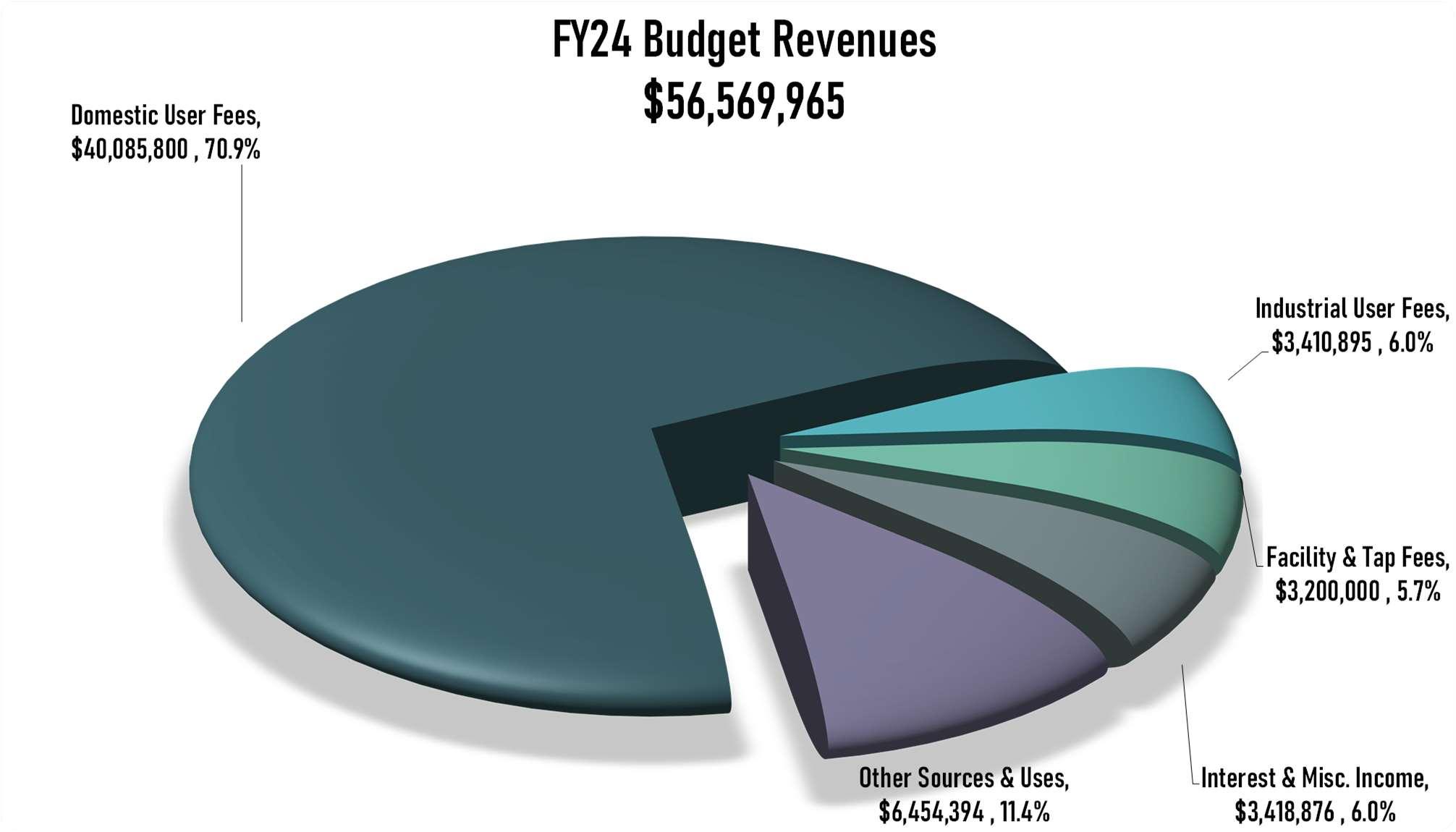
2 minute read
Component Fund Chart (continued)
The following chart shows revenues, expenditures, and transfers by individual fund and provides the detail supporting thesummary amounts.
DesignatedforInsurance
Advertisement
Now that the Districts’ financial overview has been presented, we will examine revenues and various expendituresin detail.
Revenue Overview
The District has the authority to establish rates and charges for service to be approved by a budget resolution of the District Board of Directors. The District has established separate rates for domestic and industrial customers, adopted a schedule of facility and sewer connection fees applying to new customers, and receives minor amounts of income from rental of real property and investment of surplus cash. The various types of revenues and otherfinancing sources aredescribedindetail on thefollowingpages.
A graph of historical revenues by type reveals the overwhelming percentage of the District’s income derives from domestic (residential & commercial) customers and has increased for the past ten consecutive years. Industrial user fees clearly show the effect of the shrinking textile industry in Buncombe County and are diminishingaslargerindustrieswinddownandarereplacedwithsmallernewenterprises.Facilityandtapfees testifytothegrowthfueledbypopulationin-migrationandexpansionofnon-industrialtypebusinesses.Overall, incomefor FY2023is estimatedto beslightly lowerthanin FY2022.
Revenue (continued)
Revenue Summary

When projecting FY2024 revenues, a 5.00% domestic customer rate increase was considered in conjunction withaprojected.75%increaseindomesticconsumption.Inaddition,thebudgetreflectsnogrowthinindustrial users. Conservative assumptions based on recent income trends underlie other budgeted income amounts as explained below.
Domestic User Charges
Theprimary source ofDistrict revenuesaredomestic charges.TheDistrict hasapproximately 58,000accounts. The District direct bills approximately 500 of these domestic users all of which are on private well systems but are connected to MSD’s sewer collector system. Billing and collection of the remainder of District domestic customers is performed by the member agencies providing water, who charge a fee for this service, which is added to themonthly bill and paid byMSD customers.
Domestic sewerrate increases forthepastten years are shown below:
Revenue (continued)
Industrial User Charges
Prior to FY 2001, industrial users were charged decreasing tiered rates based on total volume so that actual rates charged were considerably below those paid by residential consumers. In FY 2001, the Board approved a plan to achieve rate parity between industrial and residential customers over the upcoming twenty years. The annualincreasesfrom thisparity planareincorporatedin adoptedrates.
Fortunately, the number of new residential customers continues to increase which is anticipated to mitigate theimpact from thedeclineofindustrialrevenue.
Investment Interest
ThisrevenuesourcereflectsinterestearnedonpublicfundsheldbytheDistrictandtheRevenueBondTrustee. Investment income is determined by interest rates and cash balances available for investment. Interest rates decreased rapidly during the current year due to adverse economic conditions. The projected yield for the currentfiscalyearwill be4.00%.
AllMSDinvestmentsconformtoitsBondOrderandtheNorthCarolinaGeneralStatutesgoverninginvestments, anddueto theminimum acceptablelevel ofrisk, produce fairly conservative rates ofreturn.
Sewer System Development Fee
Thisrevenuesourcerepresentsthebuyingofequityincompletedwastewaterfacilitiespaidbyconsumerswho are added to the sewer collection system. In June 2006, the actual cost was determined to be significantly greater than the fee charged. To moderate the impact on customers, the board determined to implement 20% ofthis increaseovereach ofthesubsequent fiveyears.
On July 20, 2017 the North Carolina General Assembly passed into law North Carolina General Statute 162A Article 8 (“Article 8”). Article 8 provides for the uniform authority to implement system development fees for public water andsewersystems. In FY2024RaftelisFinancial Consultants, Inc. wasengagedto perform astudy whichconforms to theconditions and limitations ofArticle 8.
Effective in FY2024, sewer facility fees ranged from $844 to $3,568 for residential users based on size of structure,andfrom $3,568to $945,452fornonresidential customers basedon metersize.
Revenue (continued)
Sewer Connection Fees
This revenuesourcerepresentsthecostofphysically installingnewconnectionstothesewersystem.Thecost forinstallingatapthatdoesnotinvolvepaymentrestorationis$1,300. Thisfeeistoprovideconnectionstothe MSD systemwherethepublic main is on thesamesideofthestreet astheresidence.
The Sewer Connection Fee will apply to new home construction, as well as existing homes, which have been demolished or remodeled, and sewer service is reinstated under new property ownership. MSD requires that alicensedutilitycontractorinstallanysewerconnection/servicelinewithinpublicrights-of-wayextendingover 75feet or thatrequires pavementdisturbance orboringto reach across apaved thoroughfare. Theinstallation shall beconstructedto MSDStandards. All work will besubjectto MSD inspection.
Billings & Collections
TheDistrictwillpaythemunicipalities$2.83percustomerbillformeterreading,billing,andcollectionservices.
Rental Income
Pace Analytical Services, Inc. has entered into a lease to utilize a portion of a building in the Wastewater Treatment Plant facilities along with laboratory equipment. The District also leases land to a private company for acell tower.
City of Asheville (Enka Bonds Annexation)
In the Consolidation Agreements, MSD agreed to assume debt service on the $1,500,000 sanitary sewer bond issuedbytheEnka-CandlerWaterandSewerDistrict.Thisdebtwasusedtopayapartofconstructingthesewer systeminEnka-Candler,whichatthattimewaslocatedinanunincorporatedareaofwesternBuncombeCounty. After theconsolidation, theCity ofAshevilleannexedaportion oftheEnka-CandlerSewerDistrict,sotheCity of Asheville reimburses the District for its proportionate amount (41%) of the annual principal and interest payment.


